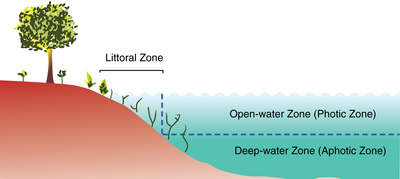
A lake ecosystem or lacustrine ecosystem includes biotic (living) plants, animals and micro-organisms, as well as abiotic (non-living) physical and chemical interactions.[1] Lake ecosystems are a prime example of lentic ecosystems (lentic refers to stationary or relatively still freshwater, from the Latin lentus, which means "sluggish"), which include ponds, lakes and wetlands, and much of this article applies to lentic ecosystems in general. Lentic ecosystems can be compared with lotic ecosystems, which involve flowing terrestrial waters such as rivers and streams. Together, these two ecosystems are examples of freshwater ecosystems.
Lentic systems are diverse, ranging from a small, temporary rainwater pool a few inches deep to Lake Baikal, which has a maximum depth of 1642 m.[2] The general distinction between pools/ponds and lakes is vague, but Brown[1] states that ponds and pools have their entire bottom surfaces exposed to light, while lakes do not. In addition, some lakes become seasonally stratified. Ponds and pools have two regions: the pelagic open water zone, and the benthic zone, which comprises the bottom and shore regions. Since lakes have deep bottom regions not exposed to light, these systems have an additional zone, the profundal.[3] These three areas can have very different abiotic conditions and, hence, host species that are specifically adapted to live there.[1]
Two important subclasses of lakes are ponds, which typically are small lakes that intergrade with wetlands, and water reservoirs. Over long periods of time, lakes, or bays within them, may gradually become enriched by nutrients and slowly fill in with organic sediments, a process called succession. When humans use the drainage basin, the volumes of sediment entering the lake can accelerate this process. The addition of sediments and nutrients to a lake is known as eutrophication.[4]
- ^ a b c Brown, A. L. (1987). Freshwater Ecology. Heinimann Educational Books, London. p. 163. ISBN 0435606220.
- ^ Brönmark, C.; L. A. Hansson (2005). The Biology of Lakes and Ponds. Oxford University Press, Oxford. p. 285. ISBN 0198516134.
- ^ Kalff, J. (2002). Limnology. Prentice Hall, Upper Saddle, NJ. p. 592. ISBN 0130337757.
- ^ Alexander, David E. (1 May 1999). Encyclopedia of Environmental Science. Springer. ISBN 0-412-74050-8.